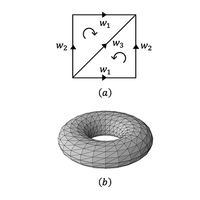加权简单复数的全局拓扑同步性
IF 2.4
3区 物理与天体物理
Q1 Mathematics
引用次数: 0
摘要
高阶网络能够捕捉复杂系统中的多体相互作用,揭示拓扑、几何和动力学之间丰富的相互作用的基本现象。简单复合物是一种高阶网络,它能编码复杂系统的高阶拓扑和动力学。具体来说,简单复合物可以维持拓扑信号,即不仅定义在网络节点上的动态变量,而且定义在其边缘、三角形等上的动态变量。拓扑信号可以发生同步等集体现象,然而,只有一些高阶网络拓扑结构才能维持拓扑信号的全局同步。在这里,我们考虑的是加权简单复合物上拓扑信号的全局拓扑同步。我们证明,拓扑信号可以在加权简单复合物上实现全局同步,即使它们是奇数维信号,如边缘信号,从而克服了非加权情况下的限制。这些结果证明,加权简单复合物比非加权复合物更有利于观察这些集体现象。我们特别介绍了两个加权简单复合物:加权三角环和加权华夫饼。我们完整地描述了它们的高阶频谱特性,并证明在适当的权重条件下,它们可以维持边缘信号的全局同步。我们从几何角度解释了我们的结果,其中包括证明了在某些情况下,边的权重可以与曲线简约的边长相关联。本文章由计算机程序翻译,如有差异,请以英文原文为准。

Global topological synchronization of weighted simplicial complexes
Higher-order networks are able to capture the many-body interactions present in complex systems and to unveil fundamental phenomena revealing the rich interplay between topology, geometry, and dynamics. Simplicial complexes are higher-order networks that encode higher-order topology and dynamics of complex systems. Specifically, simplicial complexes can sustain topological signals, i.e., dynamical variables not only defined on nodes of the network but also on their edges, triangles, and so on. Topological signals can undergo collective phenomena such as synchronization, however, only some higher-order network topologies can sustain global synchronization of topological signals. Here we consider global topological synchronization of topological signals on weighted simplicial complexes. We demonstrate that topological signals can globally synchronize on weighted simplicial complexes, even if they are odd-dimensional, e.g., edge signals, thus overcoming a limitation of the unweighted case. These results thus demonstrate that weighted simplicial complexes are more advantageous for observing these collective phenomena than their unweighted counterpart. In particular, we present two weighted simplicial complexes: the weighted triangulated torus and the weighted waffle. We completely characterize their higher-order spectral properties and demonstrate that, under suitable conditions on their weights, they can sustain global synchronization of edge signals. Our results are interpreted geometrically by showing, among the other results, that in some cases edge weights can be associated with the lengths of the sides of curved simplices.
求助全文
通过发布文献求助,成功后即可免费获取论文全文。
去求助
来源期刊

Physical review. E
物理-物理:流体与等离子体
CiteScore
4.60
自引率
16.70%
发文量
0
审稿时长
3.3 months
期刊介绍:
Physical Review E (PRE), broad and interdisciplinary in scope, focuses on collective phenomena of many-body systems, with statistical physics and nonlinear dynamics as the central themes of the journal. Physical Review E publishes recent developments in biological and soft matter physics including granular materials, colloids, complex fluids, liquid crystals, and polymers. The journal covers fluid dynamics and plasma physics and includes sections on computational and interdisciplinary physics, for example, complex networks.
 求助内容:
求助内容: 应助结果提醒方式:
应助结果提醒方式:


